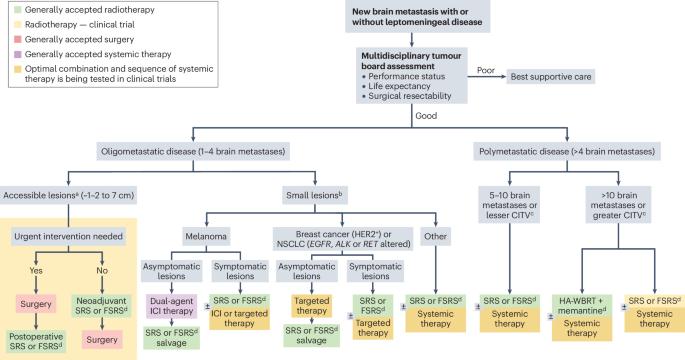Stereotactic radiosurgery for patients with brain metastases: current principles, expanding indications and opportunities for multidisciplinary care
IF 82.2
1区 医学
Q1 ONCOLOGY
引用次数: 0
Abstract
The management of brain metastases is challenging and should ideally be coordinated through a multidisciplinary approach. Stereotactic radiosurgery (SRS) has been the cornerstone of management for most patients with oligometastatic central nervous system involvement (one to four brain metastases), and several technological and therapeutic advances over the past decade have broadened the indications for SRS to include polymetastatic central nervous system involvement (>4 brain metastases), preoperative application and fractionated SRS, as well as combinatorial approaches with targeted therapy and immune-checkpoint inhibitors. For example, improved imaging and frameless head-immobilization technologies have facilitated fractionated SRS for large brain metastases or postsurgical cavities, or lesions in proximity to organs at risk. However, these opportunities come with new challenges and questions, including the implications of tumour histology as well as the role and sequencing of concurrent systemic treatments. In this Review, we discuss these advances and associated challenges in the context of ongoing clinical trials, with insights from a global group of experts, including recommendations for current clinical practice and future investigations. The updates provided herein are meaningful for all practitioners in clinical oncology. Stereotactic radiosurgery (SRS) has been established as a key therapeutic modality for the management of brain metastases. In this Review, an international group of experts discuss the expanding opportunities for SRS, including application for larger brain metastases and cumulative intracranial tumour volumes, fractionated delivery, neoadjuvant use and combinatorial approaches with modern systemic therapy, as well as associated challenges and remaining questions.


脑转移患者的立体定向放射手术:目前的原则,扩大适应症和多学科护理的机会
脑转移的管理是具有挑战性的,最好通过多学科的方法进行协调。立体定向放射手术(SRS)已成为大多数中枢神经系统少转移性受累(1 - 4个脑转移)患者治疗的基石,在过去十年中,一些技术和治疗的进步扩大了SRS的适应症,包括多转移性中枢神经系统受累(4个脑转移)、术前应用和分块SRS。以及靶向治疗和免疫检查点抑制剂的组合方法。例如,改进的成像和无框头部固定技术促进了对大面积脑转移或术后腔或危险器官附近病变的分级SRS。然而,这些机遇带来了新的挑战和问题,包括肿瘤组织学的影响以及并发全身治疗的作用和顺序。在这篇综述中,我们讨论了正在进行的临床试验背景下的这些进展和相关挑战,以及来自全球专家组的见解,包括对当前临床实践和未来研究的建议。本文提供的更新对临床肿瘤学的所有从业者都有意义。
本文章由计算机程序翻译,如有差异,请以英文原文为准。
求助全文
约1分钟内获得全文
求助全文
来源期刊
CiteScore
99.40
自引率
0.40%
发文量
114
审稿时长
6-12 weeks
期刊介绍:
Nature Reviews publishes clinical content authored by internationally renowned clinical academics and researchers, catering to readers in the medical sciences at postgraduate levels and beyond. Although targeted at practicing doctors, researchers, and academics within specific specialties, the aim is to ensure accessibility for readers across various medical disciplines. The journal features in-depth Reviews offering authoritative and current information, contextualizing topics within the history and development of a field. Perspectives, News & Views articles, and the Research Highlights section provide topical discussions, opinions, and filtered primary research from diverse medical journals.

 求助内容:
求助内容: 应助结果提醒方式:
应助结果提醒方式:


